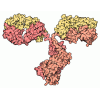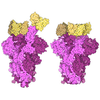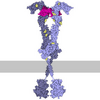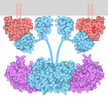+ データを開く
データを開く
- 基本情報
基本情報
| 登録情報 | データベース: PDB / ID: 9l1s | ||||||
|---|---|---|---|---|---|---|---|
| タイトル | Structure of the HER2 (S310F) - pertuzumab (T30S/D31A) complex | ||||||
 要素 要素 |
| ||||||
 キーワード キーワード | IMMUNE SYSTEM / antigen / antibody | ||||||
| 機能・相同性 |  機能・相同性情報 機能・相同性情報negative regulation of immature T cell proliferation in thymus / ERBB3:ERBB2 complex / ERBB2-ERBB4 signaling pathway / GRB7 events in ERBB2 signaling / RNA polymerase I core binding / immature T cell proliferation in thymus / semaphorin receptor complex / ErbB-3 class receptor binding / motor neuron axon guidance / Sema4D induced cell migration and growth-cone collapse ...negative regulation of immature T cell proliferation in thymus / ERBB3:ERBB2 complex / ERBB2-ERBB4 signaling pathway / GRB7 events in ERBB2 signaling / RNA polymerase I core binding / immature T cell proliferation in thymus / semaphorin receptor complex / ErbB-3 class receptor binding / motor neuron axon guidance / Sema4D induced cell migration and growth-cone collapse / regulation of microtubule-based process / PLCG1 events in ERBB2 signaling / ERBB2-EGFR signaling pathway / neurotransmitter receptor localization to postsynaptic specialization membrane / enzyme-linked receptor protein signaling pathway / ERBB2 Activates PTK6 Signaling / neuromuscular junction development / ERBB2-ERBB3 signaling pathway / Drug-mediated inhibition of ERBB2 signaling / Resistance of ERBB2 KD mutants to trastuzumab / Resistance of ERBB2 KD mutants to sapitinib / Resistance of ERBB2 KD mutants to tesevatinib / Resistance of ERBB2 KD mutants to neratinib / Resistance of ERBB2 KD mutants to osimertinib / Resistance of ERBB2 KD mutants to afatinib / Resistance of ERBB2 KD mutants to AEE788 / Resistance of ERBB2 KD mutants to lapatinib / Drug resistance in ERBB2 TMD/JMD mutants / positive regulation of Rho protein signal transduction / positive regulation of MAP kinase activity / positive regulation of transcription by RNA polymerase I / ERBB2 Regulates Cell Motility / semaphorin-plexin signaling pathway / oligodendrocyte differentiation / PI3K events in ERBB2 signaling / positive regulation of protein targeting to membrane / regulation of angiogenesis / regulation of ERK1 and ERK2 cascade / Schwann cell development / coreceptor activity / Signaling by ERBB2 / TFAP2 (AP-2) family regulates transcription of growth factors and their receptors / myelination / transmembrane receptor protein tyrosine kinase activity / GRB2 events in ERBB2 signaling / positive regulation of cell adhesion / SHC1 events in ERBB2 signaling / cell surface receptor protein tyrosine kinase signaling pathway / Downregulation of ERBB2:ERBB3 signaling / basal plasma membrane / peptidyl-tyrosine phosphorylation / Constitutive Signaling by Overexpressed ERBB2 / cellular response to epidermal growth factor stimulus / positive regulation of translation / positive regulation of epithelial cell proliferation / neuromuscular junction / phosphatidylinositol 3-kinase/protein kinase B signal transduction / wound healing / Signaling by ERBB2 TMD/JMD mutants / receptor protein-tyrosine kinase / Signaling by ERBB2 ECD mutants / receptor tyrosine kinase binding / Signaling by ERBB2 KD Mutants / cellular response to growth factor stimulus / ruffle membrane / Downregulation of ERBB2 signaling / epidermal growth factor receptor signaling pathway / neuron differentiation / Constitutive Signaling by Aberrant PI3K in Cancer / transmembrane signaling receptor activity / PIP3 activates AKT signaling / myelin sheath / heart development / presynaptic membrane / PI5P, PP2A and IER3 Regulate PI3K/AKT Signaling / RAF/MAP kinase cascade / positive regulation of cell growth / protein tyrosine kinase activity / basolateral plasma membrane / early endosome / cell surface receptor signaling pathway / cell population proliferation / protein phosphorylation / receptor complex / positive regulation of MAPK cascade / endosome membrane / intracellular signal transduction / apical plasma membrane / protein heterodimerization activity / signaling receptor binding / negative regulation of apoptotic process / perinuclear region of cytoplasm / signal transduction / nucleoplasm / ATP binding / identical protein binding / nucleus / membrane / plasma membrane / cytosol 類似検索 - 分子機能 | ||||||
| 生物種 |  Homo sapiens (ヒト) Homo sapiens (ヒト) | ||||||
| 手法 | 電子顕微鏡法 / 単粒子再構成法 / クライオ電子顕微鏡法 / 解像度: 3 Å | ||||||
 データ登録者 データ登録者 | Xu, L. / Guo, J. | ||||||
| 資金援助 |  中国, 1件 中国, 1件
| ||||||
 引用 引用 |  ジャーナル: Proc Natl Acad Sci U S A / 年: 2025 ジャーナル: Proc Natl Acad Sci U S A / 年: 2025タイトル: Computational-aided rational mutation design of pertuzumab to overcome active HER2 mutation S310F through antibody-drug conjugates. 著者: Xuefei Bai / Lingyi Xu / Zhe Wang / Xinlei Zhuang / Jiangtao Ning / Yanping Sun / Haibin Wang / Yugang Guo / Yingchun Xu / Jiangtao Guo / Shuqing Chen / Liqiang Pan /  要旨: Recurrent missense mutations in the human epidermal growth factor receptor 2 (HER2) have been identified across various human cancers. Among these mutations, the active S310F mutation in the HER2 ...Recurrent missense mutations in the human epidermal growth factor receptor 2 (HER2) have been identified across various human cancers. Among these mutations, the active S310F mutation in the HER2 extracellular domain stands out as not only oncogenic but also confers resistance to pertuzumab, an antibody drug widely used in clinical cancer therapy, by impeding its binding. In this study, we have successfully employed computational-aided rational design to undertake directed evolution of pertuzumab, resulting in the creation of an evolved pertuzumab variant named Ptz-SA. This variant, with only two mutations (T30S/D31A) located on its heavy chain, effectively reinstates binding to the mutated antigen, at the expense of a 35-fold reduction in binding affinity to HER2 (S310F) compared to the wild-type pair. Subsequently, Ptz-SA demonstrates potent killing capacity through antigen-dependent cytotoxicity. Moreover, upon engineering Ptz-SA into antibody-drug conjugates, such as Ptz-SA-MMAE, it manifests notable in vitro and in vivo antitumor efficacy by efficiently delivering cytotoxic payload into tumor cells expressing HER2 (S310F). Cryoelectron microscopy studies elucidate the molecular mechanism underlying the restored binding ability of Ptz-SA toward the S310F mutation. The steric hindrance induced by the S310F mutation is efficiently circumvented by the T30S and D31A mutations, which provides adequate space to accommodate the larger phenylalanine. Additionally, Ptz-SA also exhibits binding capacity to HER2 (S310Y), another mutation occurring at the S310 site of HER2 with high frequency. The computational-aided evolution of pertuzumab provides an alternative strategy for overcoming point mutation-mediated resistance to therapeutic antibodies. | ||||||
| 履歴 |
|
- 構造の表示
構造の表示
| 構造ビューア | 分子:  Molmil Molmil Jmol/JSmol Jmol/JSmol |
|---|
- ダウンロードとリンク
ダウンロードとリンク
- ダウンロード
ダウンロード
| PDBx/mmCIF形式 |  9l1s.cif.gz 9l1s.cif.gz | 184.8 KB | 表示 |  PDBx/mmCIF形式 PDBx/mmCIF形式 |
|---|---|---|---|---|
| PDB形式 |  pdb9l1s.ent.gz pdb9l1s.ent.gz | 141.3 KB | 表示 |  PDB形式 PDB形式 |
| PDBx/mmJSON形式 |  9l1s.json.gz 9l1s.json.gz | ツリー表示 |  PDBx/mmJSON形式 PDBx/mmJSON形式 | |
| その他 |  その他のダウンロード その他のダウンロード |
-検証レポート
| 文書・要旨 |  9l1s_validation.pdf.gz 9l1s_validation.pdf.gz | 1.2 MB | 表示 |  wwPDB検証レポート wwPDB検証レポート |
|---|---|---|---|---|
| 文書・詳細版 |  9l1s_full_validation.pdf.gz 9l1s_full_validation.pdf.gz | 1.2 MB | 表示 | |
| XML形式データ |  9l1s_validation.xml.gz 9l1s_validation.xml.gz | 36.5 KB | 表示 | |
| CIF形式データ |  9l1s_validation.cif.gz 9l1s_validation.cif.gz | 54 KB | 表示 | |
| アーカイブディレクトリ |  https://data.pdbj.org/pub/pdb/validation_reports/l1/9l1s https://data.pdbj.org/pub/pdb/validation_reports/l1/9l1s ftp://data.pdbj.org/pub/pdb/validation_reports/l1/9l1s ftp://data.pdbj.org/pub/pdb/validation_reports/l1/9l1s | HTTPS FTP |
-関連構造データ
| 関連構造データ |  62753MC M: このデータのモデリングに利用したマップデータ C: 同じ文献を引用 ( |
|---|---|
| 類似構造データ | 類似検索 - 機能・相同性  F&H 検索 F&H 検索 |
- リンク
リンク
- 集合体
集合体
| 登録構造単位 | 
|
|---|---|
| 1 |
|
- 要素
要素
| #1: タンパク質 | 分子量: 70295.781 Da / 分子数: 1 / 変異: S310F / 由来タイプ: 組換発現 / 由来: (組換発現)  Homo sapiens (ヒト) / 遺伝子: ERBB2, HER2, MLN19, NEU, NGL / 発現宿主: Homo sapiens (ヒト) / 遺伝子: ERBB2, HER2, MLN19, NEU, NGL / 発現宿主:  Homo sapiens (ヒト) / 参照: UniProt: P04626, receptor protein-tyrosine kinase Homo sapiens (ヒト) / 参照: UniProt: P04626, receptor protein-tyrosine kinase |
|---|---|
| #2: 抗体 | 分子量: 23548.152 Da / 分子数: 1 / 由来タイプ: 組換発現 / 由来: (組換発現)  Homo sapiens (ヒト) / 発現宿主: Homo sapiens (ヒト) / 発現宿主:  Homo sapiens (ヒト) Homo sapiens (ヒト) |
| #3: 抗体 | 分子量: 24201.072 Da / 分子数: 1 / 由来タイプ: 組換発現 / 由来: (組換発現)  Homo sapiens (ヒト) / 発現宿主: Homo sapiens (ヒト) / 発現宿主:  Homo sapiens (ヒト) Homo sapiens (ヒト) |
| Has protein modification | Y |
-実験情報
-実験
| 実験 | 手法: 電子顕微鏡法 |
|---|---|
| EM実験 | 試料の集合状態: PARTICLE / 3次元再構成法: 単粒子再構成法 |
- 試料調製
試料調製
| 構成要素 | 名称: HER2 (S310F) - pertuzumab (T30S/D31A) complex / タイプ: COMPLEX / Entity ID: all / 由来: RECOMBINANT |
|---|---|
| 分子量 | 実験値: NO |
| 由来(天然) | 生物種:  Homo sapiens (ヒト) Homo sapiens (ヒト) |
| 由来(組換発現) | 生物種:  Homo sapiens (ヒト) Homo sapiens (ヒト) |
| 緩衝液 | pH: 7.4 |
| 試料 | 包埋: NO / シャドウイング: NO / 染色: NO / 凍結: YES |
| 急速凍結 | 凍結剤: ETHANE |
- 電子顕微鏡撮影
電子顕微鏡撮影
| 実験機器 |  モデル: Titan Krios / 画像提供: FEI Company |
|---|---|
| 顕微鏡 | モデル: TFS KRIOS |
| 電子銃 | 電子線源:  FIELD EMISSION GUN / 加速電圧: 300 kV / 照射モード: OTHER FIELD EMISSION GUN / 加速電圧: 300 kV / 照射モード: OTHER |
| 電子レンズ | モード: BRIGHT FIELD / 最大 デフォーカス(公称値): 2000 nm / 最小 デフォーカス(公称値): 1500 nm |
| 撮影 | 電子線照射量: 64 e/Å2 フィルム・検出器のモデル: GATAN K2 SUMMIT (4k x 4k) |
- 解析
解析
| EMソフトウェア | 名称: PHENIX / バージョン: 1.19.2_4158 / カテゴリ: モデル精密化 | ||||||||||||||||||||||||
|---|---|---|---|---|---|---|---|---|---|---|---|---|---|---|---|---|---|---|---|---|---|---|---|---|---|
| CTF補正 | タイプ: PHASE FLIPPING AND AMPLITUDE CORRECTION | ||||||||||||||||||||||||
| 3次元再構成 | 解像度: 3 Å / 解像度の算出法: FSC 0.143 CUT-OFF / 粒子像の数: 167849 / 対称性のタイプ: POINT | ||||||||||||||||||||||||
| 精密化 | 最高解像度: 3 Å 立体化学のターゲット値: REAL-SPACE (WEIGHTED MAP SUM AT ATOM CENTERS) | ||||||||||||||||||||||||
| 拘束条件 |
|
 ムービー
ムービー コントローラー
コントローラー



 PDBj
PDBj











